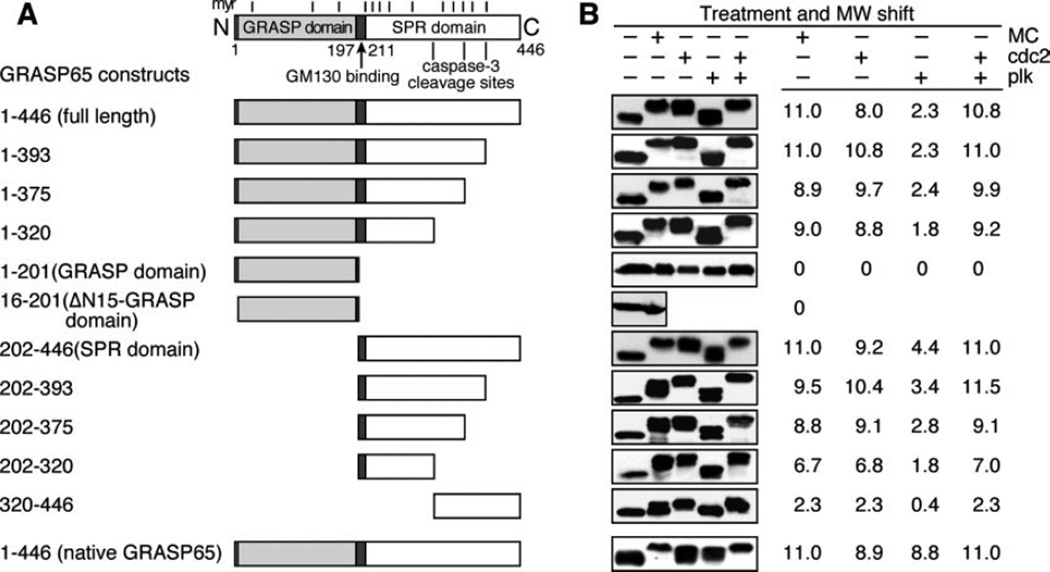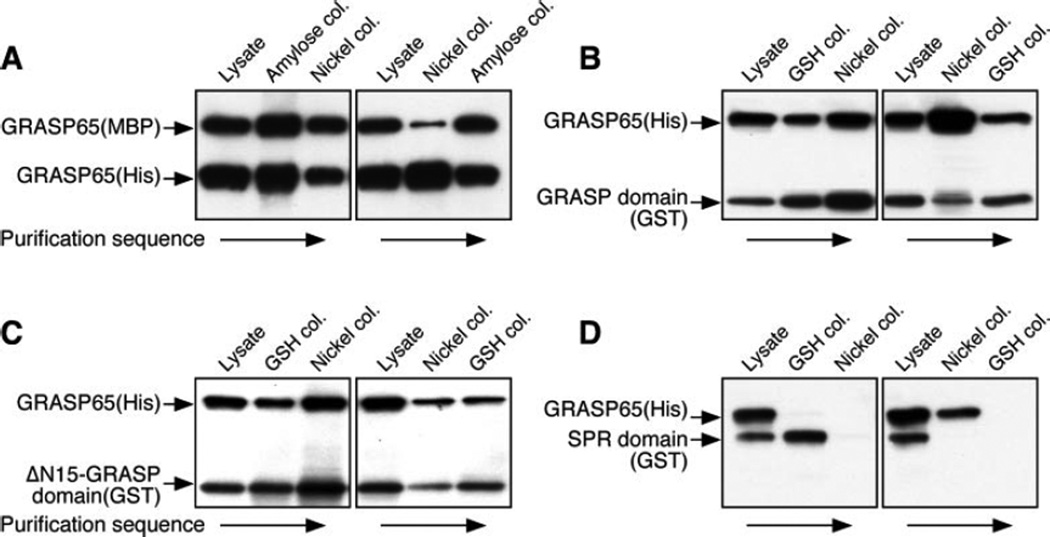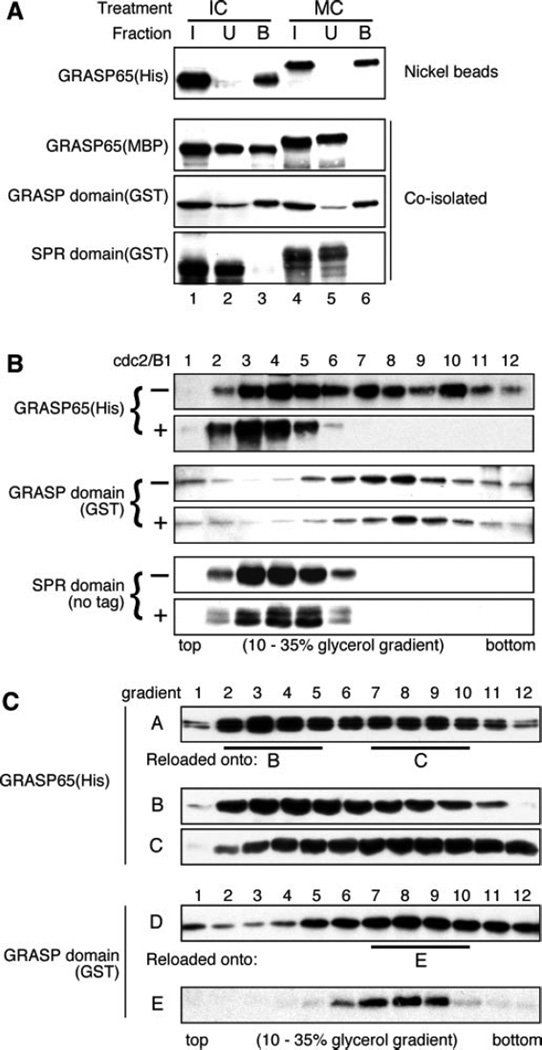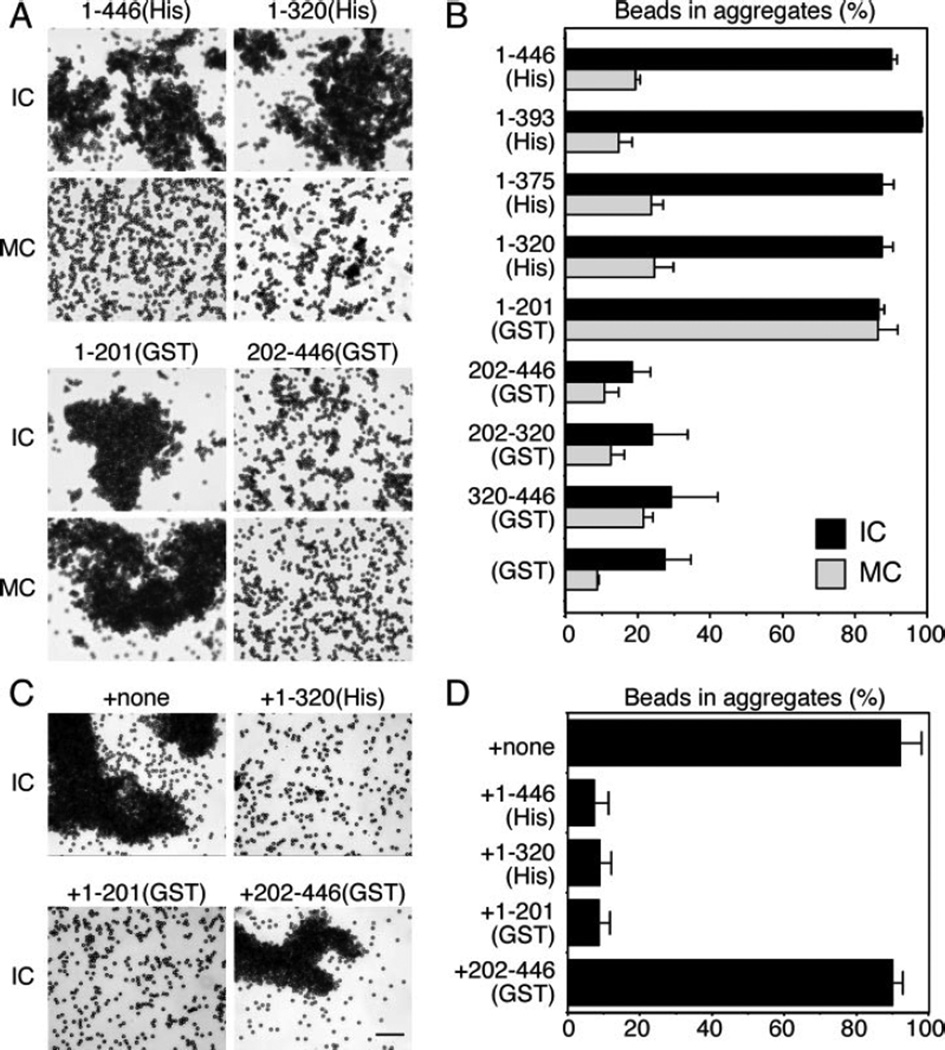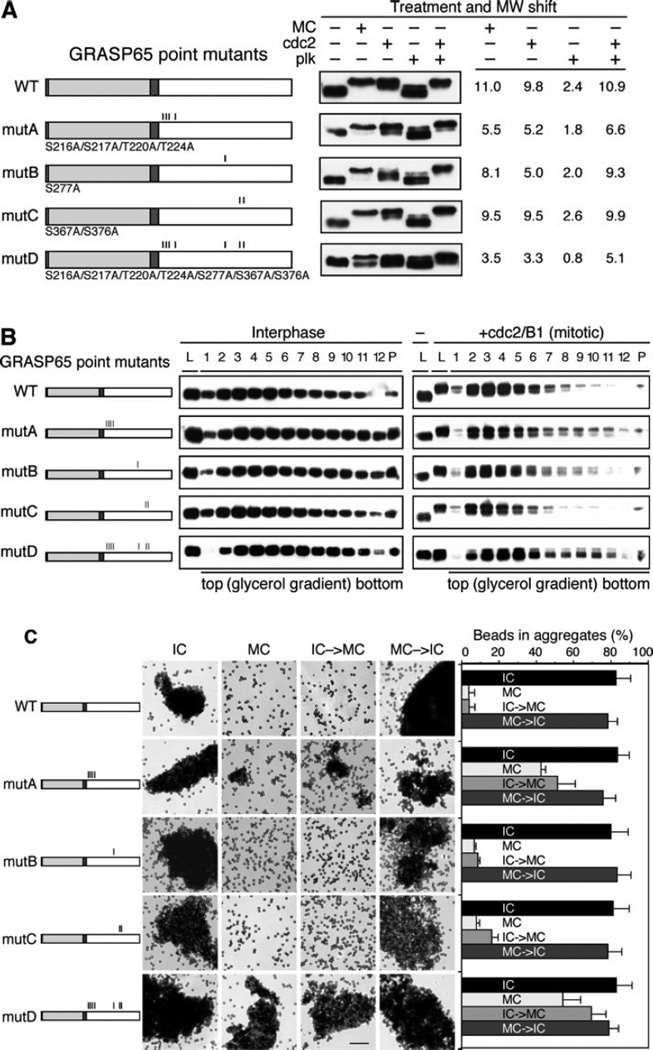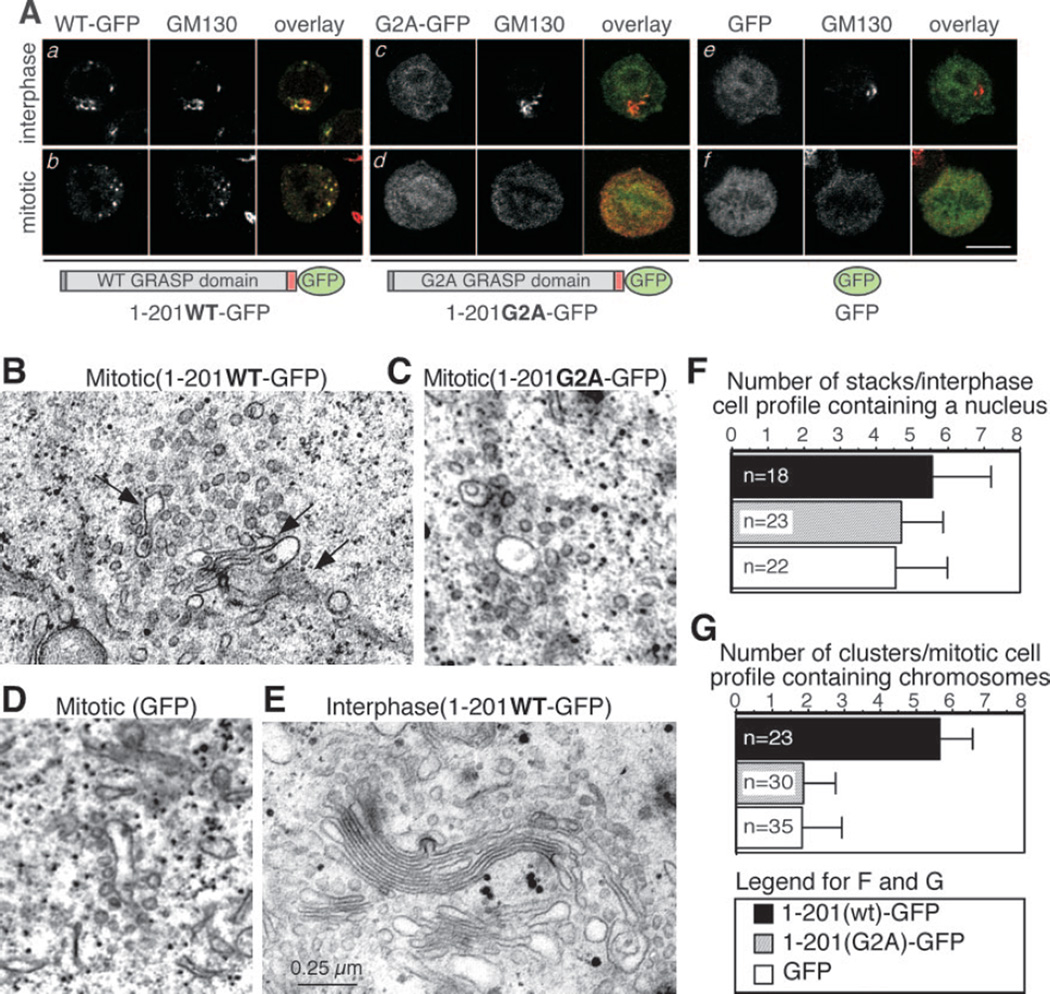Abstract
The Golgi reassembly stacking protein (GRASP) family has been implicated in the stacking of Golgi cisternae and the regulation of Golgi disassembly/reassembly during mitosis in mammalian cells. GRASP65 is a dimer that can directly link adjacent surfaces through trans-oligomerization in a mitotically regulated manner. Here we show that the N-terminal GRASP domain (amino acids 1–201) is both necessary and sufficient for dimerization and trans-oligomerization but is not mitotically regulated. The C-terminal serine/proline-rich domain (amino acids 202–446) cannot dimerize nor can it link adjacent surfaces. It does, however, confer mitotic regulation on the GRASP domain through multiple sites phosphorylated by the mitotic kinases, cdc2/B1, and the polo-like kinase. Transient expression corroborated these results by showing that the GRASP domain alone inhibited mitotic fragmentation of the Golgi apparatus.
The central and unique feature of the Golgi apparatus in most eukaryotic cells is the stack of flattened cisternal membranes with dilated rims (1). The major functions of the Golgi apparatus are thought to be modification and sorting of newly synthesized membrane and secretory proteins and lipids. The ordered structure of this organelle is thought to reflect the requirement for the enzymes and sorting machinery to be compartmentalized to allow a specific series of modifications and sorting reactions to be carried out (2). The mechanism that organizes Golgi cisternae into stacks is, therefore, of central importance to understanding Golgi functioning.
Proteins involved in stacking Golgi cisternae were first identified using cell-free assays that mimicked the cell cycle-dependent disassembly and reassembly of the Golgi apparatus (3). Termed Golgi reassembly stacking proteins (GRASPs),1 they include GRASP65 (4) and GRASP55 (5), the number referring to their apparent molecular mass (in kDa) on SDS-PAGE. Antibodies to GRASPs inhibited the restacking of newly formed cisternae, as did soluble forms of these proteins, but did not affect the reformation of the cisternae themselves. GRASP65 was also implicated in cisternal stacking in vivo. Mitotic cells injected with GRASP65 antibodies, or a soluble fragment of the protein, failed to form proper Golgi stacks in the two daughter cells after mitosis (6), showing that GRASP65 is involved in Golgi stacking at the end of mitosis. In apoptotic cells, cleavage of GRASP65 by caspase-3 correlates with Golgi fragmentation, and this is inhibited, at least partially, by the expression of a caspase-resistant form of GRASP65 (7). Both GRASPs are myristoylated at the N terminus. This, together with other binding partners (4, 8–10), ensures targeting to Golgi membranes. GRASP65 is located in cis-Golgi membranes, whereas GRASP55 is located more toward the middle of the Golgi stack (5). These locations argue that the GRASP family of proteins helps to determine the stacking of different cisternal layers (11).
GRASP65 is the major phosphorylated protein on the Golgi during mitosis (6), when the Golgi apparatus is disassembled. It is dephosphorylated at the end of mitosis, as the Golgi is assembled in the daughter cells (4). GRASP65 forms homodimers, and these can associate into higher order oligomers that can be broken down by treatment with mitotic cytosol or with two mitotic kinases, cdc2 and polo-like kinase (plk). Furthermore, beads coated with GRASP65 form large aggregates, showing that GRASP65 can link adjacent surfaces by forming trans-oligomers. These aggregates can be broken down using mitotic cytosol or the two mitotic kinases and then re-aggregated by treatment with phosphatases present in interphase cytosol (6). Because these conditions mimic the unstacking and restacking of Golgi cisternae during mitosis, they offer the best evidence to date that the GRASP family have the structural properties that are needed to stack cisternae in vivo.
What remains unclear is the relationship between trans-oligomerization and mitotic phosphorylation. GRASP65 has a clear domain structure (see Fig. 1A). The N-terminal part of the protein (amino acids 1–201) is the GRASP domain, which is highly conserved between GRASP65 and GRASP55 (5), as well as between different species (8). A short middle region contains the GM130 binding site (amino acids 197–211). GM130 is a golgin that has been implicated in vesicle tethering and restacking at the end of mitosis (12). The C-terminal part of the protein (amino acids 202–446) is a serine/proline-rich (SPR) domain. The latter is a candidate for mitotic phosphorylation, but it is not clear whether it plays a direct or indirect role in trans-oligomerization. Because an answer to this question will help us understand the Golgi stacking mechanism, we undertook an extensive series of mapping experiments to dissect the roles of the different domains.
Fig. 1. The mitotic phosphorylation sites of GRASP65 are in the C-terminal SPR domain.
A, GRASP65 structure and constructs. The upper schematic shows the domain structure of GRASP65, which comprises an N-terminal GRASP domain (myr, myristoylated N-terminal glycine) followed by a short GM130 binding region-(197–211), and a SPR domain at the C terminus. Short vertical lines above the schematic mark potential phosphorylation sites. Longer vertical lines below the schematic mark caspase-3 cleavage sites. Lower schematics(details at left) represent constructs used for phosphorylation as well as native GRASP65 (bottom). B, phosphorylation of GRASP65 and its constructs. Native GRASP65 and purified recombinant constructs were incubated with MC or the indicated kinases and immunoblotted for GRASP65. Note that the combination of cdc2/B1 and plk kinases phosphorylated GRASP65 to a similar extent as mitotic cytosol. The increases in MW were measured relative to the untreated sample.
EXPERIMENTAL PROCEDURES
Reagents
All reagents were from Sigma, Roche, or Calbiochem, unless otherwise stated. The following antibodies were used: polyclonal antibodies against GST (Amersham Biosciences) and MBP (New England Biolabs); monoclonal antibodies against GM130 (Transduction Laboratories), GRASP65 (F. Barr), and RGS-His (Qiagen). Secondary antibodies for immunofluorescence were from Molecular Probes. Antibodies against GST-GRASP65 (amino acids 202–446) and His-GRASP65 (amino acids 1–320) were raised in rabbits and purified using His-GRASP65.
Construction of GRASP65 Fusion Proteins
GRASP65 cDNAs were cloned into pMAL-c2X (New England Biolabs), pQE9 (Qiagen), pGEX (Amersham Biosciences), or pET30a (Novagen) by PCR or direct restriction digestion and confirmed by DNA sequencing. Proteins were expressed in BL21(DE3)Gold bacteria or XL-1 blue as appropriate. The proteins were purified on amylose (New England Biolabs), nickel (Qiagen), or glutathione-Sepharose (Amersham Biosciences) beads. GRASP65 point mutations were made using the QuikChange mutagenesis method (Stratagene) and confirmed by DNA sequencing.
Preparation of Kinases, Cytosols, and Golgi Membranes
Golgi membranes were purified from rat liver (13). Interphase (IC) and mitotic (MC) cytosols were prepared from HeLa S3 cells (3). Cdc2 kinase (cdc2/cyclin B1) and plk were expressed and purified as described, and kinase activity was measured (6).
Band Shift Assay for GRASP65 Phosphorylation
Phosphorylation of GRASP65 was analyzed by a band shift assay (6). Purified rat liver Golgi membranes (50 µg) or purified GRASP65 (50 ng) was treated with 500 µg of mitotic HeLa cytosol or the equivalent kinase activity for 60 min at 37 °C. Proteins were analyzed by SDS-PAGE and Western blotting. The migration distance was measured, and the size of the protein was calculated by reference to the logarithmic plot of the molecular weight standards (Bio-Rad). The extent of phosphorylation was estimated from the increase in molecular weight after treatment with kinases or mitotic cytosol.
Assays for GRASP65 Dimerization and Oligomerization
BL21-(DE3)Gold bacteria were co-transformed with GRASP65 (full-length, His-tagged) cDNA in pET30a and other GRASP65 constructs in either pMAL-c2X or pGEX. The expressed proteins were purified using sequential columns in different orders as described (6). Equal amounts of expressed protein from each purification step were analyzed by immunoblotting, and blots were quantified by directly measuring the ECL signal using Kodak Image Station 440CF. The signal intensity was compared with at least three standard samples on the same immunoblot.
To test the oligomerization of GRASP65, separately expressed and purified GRASP65 (full-length, His-tagged) and MBP or GST-tagged GRASP65 (full-length or fragments) were mixed and treated with IC or MC in the presence of 2 mm ATP and an ATP-regenerating system. The protein complex was isolated using nickel beads and analyzed by immunoblotting (6).
For sedimentation analysis, a purified GRASP65 full-length protein or a fragment was incubated at 37 °C for 1 h in gradient buffer (25 mm Hepes-KOH, pH7.4, 150 mm KCl, 5 mm MgCl2, 1 mm dithiothreitol, 2 mm ATP, and an ATP regenerating system) with or without cdc2/B1. Glycerol gradients (10–35% w/v) were centrifuged (2 h, 65,000 rpm, VTI65.1 rotor), and fractions were analyzed by Western blotting (6). In some experiments, fractions were pooled, dialyzed against gradient buffer, concentrated using centricon (Millipore), incubated as above, and reloaded onto the same type of gradient.
Aggregation Assay Using GRASP65-coated Beads
Purified recombinant GRASP65 (full-length protein or fragments) was clarified by centrifugation and cross-linked to Dynal beads M500. The beads were incubated for 60 min at 37 °C with IC or MC in the presence of 2 mm MgATP and observed under a microscope (6). In some experiments bead aggregates were washed with buffer and further incubated with the alternative cytosol. The quantitation of beads in aggregates was carried out as described previously (6).
Expression of the GRASP Domain in HeLa Cells
HeLa S3 cells were transfected with the GRASP domain (1–201, tagged with GFP at the C terminus) (5), its G2A mutant (glycine 2 mutated to alanine), or GFP alone using the FuGENE 6 transfection kit (Roche Applied Science). Cells were cultured in the presence of G418 for three passages to select transfected cells. Cells between passages 5 and 10 after transfection were used in these experiments. The mitotic synchronization of cells was performed using a 2 mm thymidine block for 24 h (14), and cells were released for 9–11 h. Cells cultured on coverslips coated with polylysine were fixed and permeabilized in methanol. The cells were labeled with a monoclonal antibody against GM130. In some experiments, DNA was stained with Hoechst 33342, and GFP was stained with polyclonal antibodies. Confocal fluorescence images were captured as described (15).
For EM, mitotic cells were collected by a shake off of cells released from a thymidine block (14), and untreated cells were fixed on the dish. After fixation using 2.5% glutaraldehyde, the cells were processed for Epon embedding. Golgi stacks and Golgi clusters were identified using morphological criteria and quantitated using standard stereological techniques (16). The average number of Golgi/cell profile was quantitated. For interphase cells, the profiles had to contain a nuclear profile with an intact nuclear envelope. For mitotic cells, the profile had to contain one or more profiles of condensed chromosomes lacking a nuclear envelope. Results were from three independent experiments.
RESULTS
Mitotic Phosphorylation Sites on GRASP65 Are in the Cterminal Half of the Protein
Phosphorylation sites predicted by the computer program (Prosite combined with the S/T-P criteria) are enriched in the C-terminal half (SPR domain) of GRASP65, although there are a few potential sites in the N-terminal region (Fig. 1A, top, vertical lines). To identify those that were targets of mitotic kinases, cDNAs encoding different segments of GRASP65 were constructed, expressed in bacteria, and purified via the attached tags. They were then incubated with MC or the mitotic kinases, cdc2/B1 and plk.
A previous study showed that phosphorylation of GRASP65 causes an increase in apparent molecular weight (MW) on SDS-PAGE and so can be used to assess the extent of phosphorylation (6). As shown in Fig. 1B, constructs containing all or part of the C-terminal domain increased in MW upon kinase treatment. The longer the C-terminal fragment, the larger the molecular shift observed. Protein constructs containing only the N-terminal GRASP domain showed no shift in MW at all. Maximal phosphorylation was obtained using mitotic cytosol, and this was only matched using a combination of both cdc2/B1 and plk. The extent of mobility shift was not affected by the nature of the tag used to purify the construct. Together these results show that the phosphorylation sites causing the band-shift of GRASP65 are restricted to the C-terminal SPR domain.
The GRASP Domain Is Both Necessary and Sufficient for Dimerization
To identify the domain mediating dimerization of GRASP65, the full-length protein was co-expressed with constructs covering different regions. These constructs were tagged differently to allow sequential purification using each tag in turn. As shown in Fig. 2A, when the two full-length proteins GRASP65(MBP) and GRASP65(His) were co-expressed, they co-purified through a two-step purification using amylose and nickel columns. The final ratio of the two proteins in the co-purified complex was ~1:1 (Fig. 2). Similar results were obtained by Coomassie Blue staining, taking into account the different molecular weights of the proteins. This ratio was unaffected by the order in which the columns were used for purification, suggesting that the mixed complex is a dimer. If it had been a higher order oligomer then the final ratio would reflect the relative expression levels of the two constructs. In fact the ~1:1 ratio was obtained over a 5-fold range of expression of His-GRASP65 to MBP-GRASP65 (6).
Fig. 2. The N-terminal GRASP domain is both necessary and sufficient for dimerization.
GRASP65 (His-tagged) was co-expressed with A, GRASP65 (full-length, MBP-tagged); B, GRASP domain (1–201, GST-tagged); C, ΔN15-GRASP domain (16–201, GST-tagged);or D, SPR domain (202–446, GST tagged) in Escherichia coli and purified sequentially on amylose or glutathione columns followed by a nickel column (Left panels in each pair), or the reverse (Right panels in each pair). Equal amounts of protein from each purification step were analyzed by immunoblotting for GRASP65 or the tag. Note that, in A–C, the ratio of the two proteins in the final isolated complex is ~1:1, irrespective of the expression levels or the order in which the columns were used for purification.
When the GRASP domain (tagged with GST), or the ΔN15-GRASP domain (a truncated form of the GRASP domain lacking the N-terminal myristoylation signal), was co-expressed with full-length GRASP65(His), the two proteins yielded a ~1:1 ratio irrespective of the order of the columns, again consistent with a dimer (Fig. 2, B and C). In contrast, when the SPR domain was co-expressed with the full-length protein, these two proteins did not co-purify (Fig. 2D). Other C-terminal fragments were also co-expressed with the full-length protein, but none of them co-purified (not shown). These data show that the N-terminal GRASP domain is involved in dimerization of the protein.
The GRASP Domain Is Necessary and Sufficient for Trans-oligomerization but Is Not Mitotically Regulated
To link adjacent surfaces, GRASP65 dimers need to form oligomers, and these must be arranged in trans. To identify the domains required for oligomerization, the full-length protein GRASP65-(His) was mixed with purified GRASP65 fragments. After incubation under interphase or mitotic conditions, the full-length protein was isolated using nickel beads, and co-isolation of the fragments was analyzed. As shown in Fig. 3A, the efficiency of GRASP65(His) pull down is high, because almost all of the GRASP65(His) was found in the bead fraction (Fig. 3A). MBP-tagged, full-length GRASP65 co-isolated with GRASP65(His) under interphase but not mitotic conditions when both proteins were phosphorylated as indicated by the increase in MW. The GRASP domain (tagged with GST) also co-isolated with GRASP65(His), under both interphase and mitotic conditions, suggesting that binding is not mitotically regulated, consistent with the lack of mitotic phosphorylation sites in this region (Fig. 1B). In contrast, the SPR domain (tagged with GST) did not interact with the full-length protein at all under either condition (Fig. 3A). Two other C-terminal fragments, 202–320 and 320–446, also did not interact with the full-length protein (data not shown). These results show that the GRASP domain alone is sufficient to interact with the full-length protein to form oligomers and suggest that this interaction is not mitotically regulated.
Fig. 3. The GRASP domain is necessary and sufficient for oligomerization but is not mitotically regulated.
A, GRASP65 (full-length, His-tagged) was ncubated with either GRASP65 (full-length, MBP-tagged), the GRASP domain (1–201, GST-tagged), or the SPR domain (202–446, GST-tagged), in the presence of interphase (IC, lanes 1–3) or mitotic cytosol (MC, lanes 4–6). The protein complex was then isolated using nickel beads. Equal portions of the input (I), unbound (U), or bound (B) fractions were analyzed by immunoblotting for GRASP65. Note the presence of the GRASP domain in the bound complexes pre-incubated with either interphase or mitotic cytosol (lanes 3 and 6). B, GRASP65, the GRASP domain, and the SPR domain were each purified and incubated in the presence or absence of cdc2/B1, sedimented in glycerol gradients, and fractions were analyzed by immunoblotting. Note that the GRASP domain was necessary for rapid sedimentation and, when present alone (without the SPR domain), was unaffected by treatment with mitotic kinase. C, GRASP65 or the GRASP domain were sedimented in glycerol gradients as in B, and the indicated fractions from each gradient were pooled, dialyzed, concentrated, and reloaded onto a similar gradient. Note that the GRASP domain, but not full-length GRASP65, was stable to recentrifugation.
As an alternative approach to study oligomerization, the full-length protein, the GRASP domain, or the SPR domain was treated with or without cdc2/B1 and loaded onto a 10–35% glycerol gradient to separate oligomers from dimers. As shown in Fig. 3B, a large fraction of GRASP65 sedimented toward the bottom of the gradient, consistent with the formation of oligomers. This did not happen after treatment with cdc2/B1, with most of the GRASP65 peaking in fractions 3 and 4, the same as dimeric bovine serum albumin (not shown), which has a similar MW. This shows that oligomerization of GRASP65 is mitotically regulated. In contrast, almost all of the GRASP domain sedimented rapidly, irrespective of the treatment, suggesting that it formed oligomers that were not disrupted under mitotic conditions (Fig. 3B). The SPR domain did not form oligomers at all, under either condition (Fig. 3B). These results were confirmed and extended using a number of other GRASP65 constructs (supplemental Fig. 1). Together these data show that the GRASP domain is both necessary and sufficient for oligomerization but is not mitotically regulated.
Interestingly, and in marked contrast to full-length GRASP65, almost all of the GRASP domain construct sedimented as oligomers, with little or no protein present in the dimer fraction (Fig. 3B). This was independent of the tag used (supplemental Fig. 1) and suggested that the GRASP domain forms more stable oligomers than GRASP65. To test this possibility, fractions were pooled and rerun on the same type of gradient. As shown in Fig. 3C, the pooled GRASP65 dimers ran as dimers and oligomers, as did the GRASP65 oligomers, suggesting that the dimers and oligomers are in equilibrium with approximately equal amounts in each fraction. The pooled GRASP domain oligomers only ran as oligomers suggesting that they are much more stable than the GRASP65 oligomers. This in turn suggests that the presence of the SPR domain destabilizes the interaction between the GRASP domain dimers.
The bead assay was then used to show that the oligomers formed were arranged in trans (6). Dynal beads were coated with different GRASP65 fragments by cross-linking and incubated in the presence of interphase or mitotic cytosols. Representative images for some of the constructs are shown in Fig. 4A and quantitation for all of the constructs is shown in Fig. 4B.
Fig. 4. The GRASP domain is necessary and sufficient for trans-oligomerization (bead aggregation) but is not mitotically regulated.
A, purified GRASP65 constructs were covalently coupled to Dynal beads and incubated with IC (upper panels) or MC (lower panels). After incubation the beads were transferred to glass slides, and random fields were photographed. A representative image of each condition is shown. B, quantitation of (A) and of beads coated with other GRASP65 constructs. Results are shown as the mean ± S.E. from three independent experiments. Note that aggregation requires the GRASP domain, but mitotic regulation requires the SPR domain. C, Dynal beads coated with His-GRASP65 were incubated with interphase cytosol in the presence of the indicated GRASP65 constructs. Representative images are shown. Bar, 500 µm. D, quantitation of (C). Note that aggregation is only inhibited by constructs containing the GRASP domain.
Beads coated with fragments containing the GRASP domain all formed large aggregates under interphase conditions (Fig. 4, A and B). Aggregation was not affected by removal of all or part of the SPR domain suggesting that this domain plays no role in trans-oligomerization. However, the removal of the SPR domain abolished the ability of mitotic cytosol to disaggregate the beads. The presence of about half the SPR domain-(201–320) was needed for this ability. Beads coated with the SPR domain alone, or any other C-terminal fragments of SPR, did not form large aggregates and these were only modestly influenced by MC (Fig. 4, A and B).
The converse experiment was also carried out, using fragments of GRASP65 to inhibit the aggregation of beads coated with full-length GRASP65. Representative images are shown in Fig. 4C, and the quantitation is shown in Fig. 4D. Only fragments containing the GRASP domain inhibited aggregation of the beads. The SPR domain alone had no effect. Together these experiments strongly suggest that the GRASP domain is responsible for trans-oligomerization, and this is mitotically regulated by the SPR domain, and in particular by residues 202–320.
Mapping the Regulatory Phosphorylation Sites in the SPR Domain
The minimal consensus sequence for cdc2, plk, and other mitotic kinases is (S/T)-P (17), and there are seven such sites in the SPR domain. The ones within the critical region-(202–320) or near to it, together with the adjacent serines and threonines, were mutated alone and in combination in the full-length protein, then expressed in bacteria, and purified via the His-tag (Fig. 5A, mutA–D).
Fig. 5. Mitotic phosphorylation sites in the SPR domain of GRASP65.
A, potential sites (serines and threonines indicated by lines) were mutated to alanines (left panel), and the purified proteins incubated with MC or the indicated kinases followed by SDS-PAGE and immunoblotting for GRASP65 (middle panel). Calculated shifts in molecular weight are shown at right. The shifts were inversely correlated to the number of sites mutated. B, phosphorylation mutants of GRASP65 (lines above schematics at left) were incubated with interphase cytosol (middle panel) or the mitotic kinase cdc2/B1 (right panel), sedimented in glycerol gradients, and blotted for GRASP65. Note the increase in MW after kinase treatment in the right panel. L, 10% input; P, pellet. C, Dynal beads coated with different GRASP65 phosphorylation mutants (lines above schematics at left) were incubated with IC or MC, or a sequence of cytosols (IC->MC or MC->IC). Bar, 500 µm. Quantitation of the results is shown at right. Note that mutation of all seven sites dramatically inhibited disaggregation by MC.
These purified proteins were then treated with mitotic cytosol or kinases, and their phosphorylation was assessed using the band-shift assay. There was an inverse correlation between the shift in MW and the number of sites mutated. Mutation of all these sites did not completely abolish the band shift (Fig. 5A, mutD), because there are potential phosphorylation sites at the C terminus which were not mutated, and there are more serines and threonines in this region which do not fit the (S/T)-P criteria but could possibly be phosphorylated.
The effects of these point mutations on oligomerization were tested first using glycerol gradients. Purified proteins were incubated with or without purified cdc2 kinase and after centrifugation and fractionation, GRASP65 was detected by immunoblotting. Under interphase conditions, the pattern of sedimentation was the same for both the wild-type and the mutant proteins. A fraction of the protein sedimented rapidly in each case showing that mutation of the sites per se had no effect on the ability of GRASP65 to oligomerize (Fig. 5B, WT versus mutA–D). Under mitotic conditions, very little of the wild type GRASP65 formed oligomers and mutation of one or two potential phosphorylation sites had very little effect (Fig. 5B, mutB and mutC). However, mutation of more sites, such as those near the beginning of the SPR domain (mutA), had a greater effect. Under mitotic conditions, a significant fraction sedimented rapidly toward the bottom of the gradient. When all these sites were mutated, more GRASP65 sedimented rapidly, and a peak at fraction 10 could be detected (Fig. 5B, mutD). These results show that multiple phosphorylation sites are responsible for the regulation of oligomerization.
These mutants were also tested for their effect on trans-oligomerization using the bead assay. Under interphase conditions, beads coated with each of the mutant proteins aggregated to exactly the same extent as the wild type protein. Under mitotic conditions, with one exception (mutD), aggregation also did not occur. Transfer from MC to IC led to aggregation, whereas treatment with IC followed by MC led to aggregates undergoing dispersal. The exception was mutD in which seven phosphorylation sites were mutated. These formed aggregates even under mitotic conditions and aggregates formed in IC could not be disaggregated using MC (Fig. 5C). These data show that trans-oligomerization is regulated by multiple phosphorylation sites.
Mitotic Regulation of Oligomerization in Vivo
If the GRASP domain mediates trans-oligomerization but cannot be mitotically regulated then it might be expected to inhibit the unstacking of the Golgi at the onset of mitosis. To test this, the GRASP domain was tagged at the C terminus with GFP so that it could be visualized, and a stable HeLa cell line was generated. As a control, the N-terminal myristoylation signal was removed so that GRASP should no longer be able to bind to Golgi membranes. GFP alone was used as another control (Fig. 6A). Immunoblot analysis showed each of the constructs was stably expressed at equivalent levels in each of the stable cell lines (data not shown).
Fig. 6. GRASP65 is involved in stacking in vivo.
A, HeLa cells were stably transfected with the constructs schematized beneath the images. Representative fluorescence images of interphase (upper panels) and mitotic (lower panels) cells double-labeled with the Golgi marker, GM130. Note that the N-terminal myristoylation signal is needed for Golgi localization. Bar, 10 µm. B–G, representative EM images of mitotic (B–D) and interphase (E) cells and quantitation (F, G). Results expressed as the mean ± S.E. from three independent experiments (n = number of cell profiles counted). Note that the GRASP domain inhibits fragmentation during mitosis but only when localized to the Golgi by the N-terminal myristoylation signal. Bar, 0.25 µm.
Fluorescence analysis showed that the GRASP domain localized to the Golgi in interphase cells as shown by co-staining for GM130 (Fig. 6A, a). GRASP lacking the N-terminal myristoylation signal was present throughout the cytoplasm, as was GFP (Fig. 6A, c and e). In mitotic cells, the wild type GRASP domain co-localized with GM130 on the mitotic clusters (Fig. 6A, b), whereas the G2A mutant (Fig. 6A, d) or GFP alone (Fig. 6A, f) was found to be cytosolic. Notably, mitotic cells expressing the wild type GRASP65 domain showed an increased number of mitotic clusters, as indicated by GM130, compared with those expressing the G2A mutant or GFP alone (Fig. 6A, b versus d and f).
Examination of cells at the EM level showed no qualitative (Fig. 6E and data not shown) or quantitative (Fig. 6F) difference in the appearance of the interphase Golgi for each of the stable cell lines. However, in agreement with the fluorescence data, mitotic cells expressing the GRASP domain had more and bigger Golgi clusters than those expressing the myristoylation mutant or GFP alone (Fig. 6, compare B with C and D). Quantitation showed there were at least three times as many clusters for each cell profile, whereas in interphase cells there was no significant difference in the number of Golgi stacks/cell profile (Fig. 6G). These results corroborate the in vitro data (Figs. 3 and 4) suggesting that the lack of mitotic regulation of the GRASP domain helps prevent the breakdown and dispersal of Golgi fragments during mitosis.
DISCUSSION
Through mapping experiments we have been able to dissect the GRASP65 protein into two functional domains. The N-terminal, or GRASP domain, is a dimer that is involved in trans-oligomerization. The C-terminal, or SPR domain, regulates this trans-oligomerization through phosphorylation by mitotic kinases. In the absence of the SPR domain, the GRASP domain forms trans-oligomers, but these are not mitotically regulated. Beads coated with the GRASP domain still aggregate but cannot be broken up by mitotic kinases. Cells stably expressing the GRASP domain have bigger mitotic Golgi clusters during mitosis, again, consistent with a lack of mitotic regulation.
Perhaps the most intriguing and unexpected result is that GRASP65 dimers form higher order oligomers more efficiently when the regulatory SPR domain is removed (Fig. 3, B and C and supplemental Fig. 1). Hence, in glycerol gradients, the full-length GRASP65 comprises a mixture of different forms, from dimers to higher order oligomers. When pooled fractions of dimers or oligomers are rerun on the gradients, the original pattern is obtained, showing that the different forms are readily interconvertible. In marked contrast, however, the GRASP domain forms oligomers with little evidence of any dimers on the gradient. Furthermore, when pooled fractions of these oligomers were rerun on the gradient, only oligomers were found, attesting to their stability. These oligomers were also resistant to treatment with mitotic kinases.
These data therefore suggest that the SPR domain normally prevents the GRASP domain from forming stable oligomers. A possible reason is the need to break down GRASP65 oligomers during mitosis, so that cisternal unstacking can occur. The nature of the interaction between GRASP domain dimers might preclude direct phosphorylation as a means of breaking down the oligomers. It has to be done indirectly, via phosphorylation of the SPR domain. But such an indirect method might not work unless the system is poised for breakdown. Hence the SPR domain would act to prevent tight association of GRASP domain dimers so that phosphorylation tips the balance toward breakdown. Of course, one possible explanation for these results is that the full-length GRASP65 is not properly folded, whereas the GRASP domain is. This seems, however, unlikely. The full-length GRASP65 forms dimers, and the higher order oligomers can be reversibly disaggregated under mitotic conditions either in solution (Fig. 3) or when attached to beads (Fig. 4).
This suggestion is supported by the number of sites that need to be phosphorylated in order for oligomer breakdown to occur as well as their distribution. There is a cluster of sites near to the GRASP domain that has a particularly marked effect on oligomer breakdown. Mutation of other sites has little effect on the mitotic regulation of trans-oligomerization, as measured by bead aggregation. However, the additional mutation of this cluster of sites markedly prevented mitotic regulation (Fig. 5C). Perhaps this cluster helps to prize apart the end of the GRASP domain oligomer, leading to eventual disassembly. Such a model, in turn, would suggest that the oligomers comprise parallel arrays of dimers, which are themselves arranged in parallel. This would give maximum leverage to phosphorylation of the clusters. Further structural work will be needed to test this hypothesis.
What remains unclear is the role played by the rest of the SPR domain. There are phosphorylation sites that contribute toward oligomer disassembly, but these are widely spaced apart. Perhaps the initial separation of the dimers is followed by interdigitation of the phosphorylated SPR domain to continue the disassembly process or to inhibit reassembly under mitotic conditions. Experiments are in progress to determine whether there is any binding of the phosphorylated SPR domain to the GRASP domain.
One other possibility has to do with the known cleavage pattern of GRASP65 during apoptosis. Lowe and colleagues (7) mapped the three cleavage sites of caspase-3 to the SPR domain. This leads to fragmentation of the Golgi, although our data would now suggest that this is an indirect effect. None of our experiments suggest a role for the SPR domain in linking adjacent surfaces. Not only does it not form dimers or oligomers (Figs. 2 and 3), it does not link beads together and also does not inhibit aggregation of beads coated with a full-length protein (Fig. 4). One possibility is that the cleaved fragments of the SPR domain act as signaling molecules for apoptosis. There is some precedent for this with the tethering factor p115, a fragment of which enters the nucleus and promotes apoptosis (18). One similar characteristic of all these apoptotic fragments from GRASP65 and p115 is a low isoelectronic point (≤4), which is possibly important for transport into the nucleus.
In conclusion, our mapping experiments have separated the structural and functional domains of the GRASP65 stacking protein. Further structural experiments are now needed to work out the manner in which these domains operate together to regulate the stacking of Golgi cisternae in vivo.
Supplementary Material
Acknowledgments
We thank Baorong Shi for help with protein expression, purification, and EM. We thank Janet Lee for help with cDNA cloning. We also thank Joachim Seemann for GRASP65 constructs for mammalian expression, Matthew Beard for critical reading of the manuscript, and the entire Warren/Mellman group for discussions and support.
Footnotes
This work was supported by the National Institutes of Health. The costs of publication of this article were defrayed in part by the payment of page charges. This article must therefore be hereby marked “advertisement” in accordance with 18 U.S.C. Section 1734 solely to indicate this fact.
The on-line version of this article (available at http://www.jbc.org) contains supplemental Fig. 1.
Supported by the American Heart Association.
The abbreviations used are: GRASP(s), Golgi reassembly stacking protein(s); plk, polo-like kinase; SPR, serine/proline-rich; GST, glutathione S-transferase; IC, interphase cytosols; MBP, Maltose-binding protein; MC, mitotic cytosols; MW, molecular weight.
REFERENCES
- 1.Rambourg A, Clermont Y. In: The Golgi Apparatus. Berger EG, Roth J, editors. Switzerland: Birkhauser Verlag, Basel; 1997. pp. 37–61. [Google Scholar]
- 2.Farquhar MG, Palade GE. Trends Cell Biol. 1998;8:2–10. doi: 10.1016/S0962-8924(97)01187-2. [DOI] [PMC free article] [PubMed] [Google Scholar]
- 3.Rabouille C, Misteli T, Watson R, Warren G. J. Cell Biol. 1995;129:605–618. doi: 10.1083/jcb.129.3.605. [DOI] [PMC free article] [PubMed] [Google Scholar]
- 4.Barr FA, Puype M, Vandekerckhove J, Warren G. Cell. 1997;91:253–262. doi: 10.1016/s0092-8674(00)80407-9. [DOI] [PubMed] [Google Scholar]
- 5.Shorter J, Watson R, Giannakou ME, Clarke M, Warren G, Barr FA. EMBO J. 1999;18:4949–4960. doi: 10.1093/emboj/18.18.4949. [DOI] [PMC free article] [PubMed] [Google Scholar]
- 6.Wang Y, Seemann J, Pypaert M, Shorter J, Warren G. EMBO J. 2003;22:3279–3290. doi: 10.1093/emboj/cdg317. [DOI] [PMC free article] [PubMed] [Google Scholar]
- 7.Lane JD, Lucocq J, Pryde J, Barr FA, Woodman PG, Allan VJ, Lowe M. J. Cell Biol. 2002;156:495–509. doi: 10.1083/jcb.200110007. [DOI] [PMC free article] [PubMed] [Google Scholar]
- 8.Barr FA, Nakamura N, Warren G. EMBO J. 1998;17:3258–3268. doi: 10.1093/emboj/17.12.3258. [DOI] [PMC free article] [PubMed] [Google Scholar]
- 9.Barr FA, Preisinger C, Kopajtich R, Korner R. J. Cell Biol. 2001;155:885–891. doi: 10.1083/jcb.200108102. [DOI] [PMC free article] [PubMed] [Google Scholar]
- 10.Kuo A, Zhong C, Lane WS, Derynck R. EMBO J. 2000;19:6427–6439. doi: 10.1093/emboj/19.23.6427. [DOI] [PMC free article] [PubMed] [Google Scholar]
- 11.Pfeffer SR. J. Cell Biol. 2001;155:873–875. doi: 10.1083/jcb.200109095. [DOI] [PMC free article] [PubMed] [Google Scholar]
- 12.Nakamura N, Lowe M, Levine TP, Rabouille C, Warren G. Cell. 1997;89:445–455. doi: 10.1016/s0092-8674(00)80225-1. [DOI] [PubMed] [Google Scholar]
- 13.Hui N, Nakamura N, Slusarewicz P, Warren G. In: Cell Biology: A Laboratory Handbook. Celis J, editor. Vol. 2. San Diego: Academic Press; 1998. pp. 46–55. [Google Scholar]
- 14.Klevecz RR. Methods Cell Biol. 1975;10:157–172. doi: 10.1016/s0091-679x(08)60735-9. [DOI] [PubMed] [Google Scholar]
- 15.Axelsson MA, Warren G. Mol. Biol. Cell. 2004 doi: 10.1091/mbc.E03-07-0459. [DOI] [PMC free article] [PubMed] [Google Scholar]
- 16.Souter E, Pypaert M, Warren G. J. Cell Biol. 1993;122:533–540. doi: 10.1083/jcb.122.3.533. [DOI] [PMC free article] [PubMed] [Google Scholar]
- 17.Davis FM, Tsao TY, Fowler SK, Rao PN. Proc. Natl. Acad. Sci. U. S. A. 1983;80:2926–2930. doi: 10.1073/pnas.80.10.2926. [DOI] [PMC free article] [PubMed] [Google Scholar]
- 18.Chiu R, Novikov L, Mukherjee S, Shields D. J. Cell Biol. 2002;159:637–648. doi: 10.1083/jcb.200208013. [DOI] [PMC free article] [PubMed] [Google Scholar]
Associated Data
This section collects any data citations, data availability statements, or supplementary materials included in this article.



